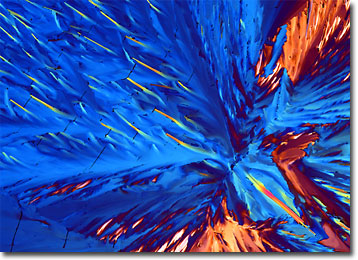Polarized Light Microscopy Digital Image Gallery
Sulforaphane
Parents have a reputation for urging their children to eat all of the vegetables put on their plate, even the infamously dreaded broccoli, which was publicly decried by George Bush Sr. while he was President of the United States. Recent research into sulforaphane, a cancer-fighting substance found in broccoli and other cruciferous plants, helps reinforce the wisdom of such parental demands.

Sulforaphane is a naturally occurring sulfur-containing isothiocyanate derivative that is hydrolyzed from its precursor when plant tissues are crushed or chewed. Soon after ingestion, the phytochemical begins to act within the body, triggering an immune system response to carcinogens. More specifically, sulforaphane induces a series of proteins known as phase 2 detoxification enzymes to scavenge for carcinogenic substances before they are able to promote cancer. Unlike many vitamins, however, the effects of the indirect oxidant may be experienced by cells throughout the entire body and may persist for several days.
Although sulforaphane has been successfully synthesized in the laboratory, the chiral sulfur compound is still obtained from plant extracts for commercial use. One of the best sources to utilize for such purposes was discovered by a team of researchers associated with The John Hopkins University School of Medicine, who found that broccoli sprouts contain 20 to 50 times the amount of sulforaphane than the mature heads. Laboratory studies have also revealed important information about the phytochemical. For instance, rats that were fed sulforaphane-containing foods and were then exposed to a strong carcinogen developed dramatically smaller and fewer tumors than test subjects that did not ingest the compound before exposure to a cancer-causing agent.
